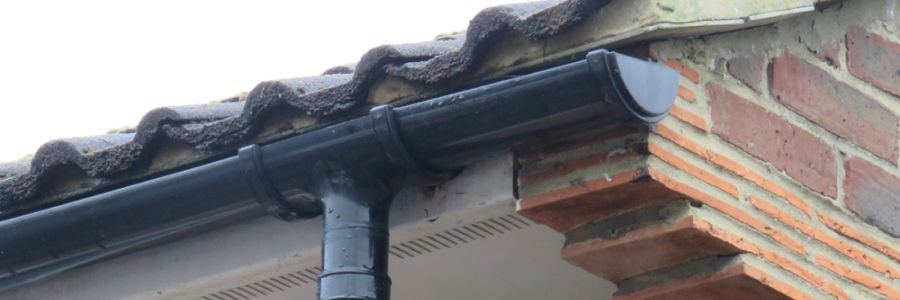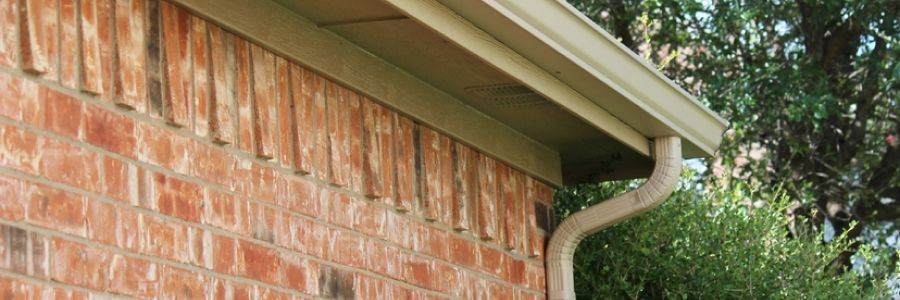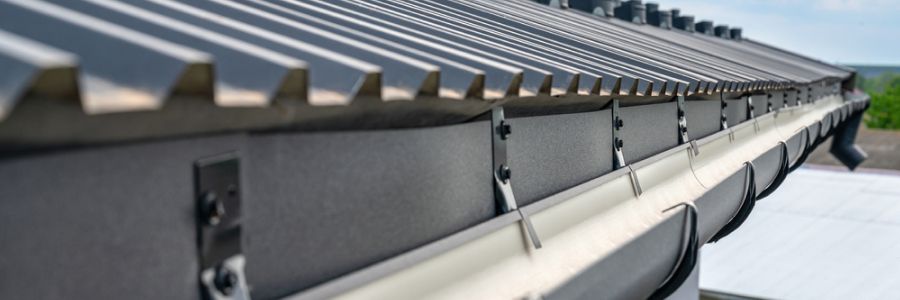Protect your property against water damage, leaks and mould by understanding the types of gutters available and choosing the best one for you.
Types of Gutters
Traditional Sectional Gutters
Uses
- Rainwater collection
- Diversion of water away from a building's foundation
- Suitable for residential homes, historical buildings, and structures where maintaining a classic aesthetic is important
Structure
These gutters are constructed in smaller sections, which are then joined together around the roof's edge. The design can often be customised to fit the architecture of a building.
Pros
- Cost Effective: Sectional gutters are budget-friendly due to being built in sections, instead of one continuous piece.
- Aesthetic Appeal: Their classic design enhances the looks of traditional and historic homes.
- Customisation: Available in various styles and materials, allowing for a tailored appearance.
- Replaceability: Damaged sections can be replaced without needing to change the entire gutter system.
Cons
- Seam Leakage: The seams between sections can become a source of leaks over time.
- Maintenance Intensive: Requires regular cleaning and inspection to prevent clogging and seam damage.
- Installation Complexity: Labour-intensive to install compared to seamless gutters.
Material
Traditional sectional gutters come in a variety of materials, including:
- Aluminium: Lightweight and rust-resistant, but may not suit the aesthetic of older buildings.
- Copper: Offers a distinctive look with excellent durability; develops a patina over time.
- Steel: Strong and long-lasting, but susceptible to rust if not properly maintained.
- Vinyl: Cost-effective and easy to install, but not as durable as metal options and may not align with traditional aesthetics.
Traditional sectional gutters are particularly suitable for homeowners seeking to preserve or enhance the traditional look of their properties, though they do require a commitment to regular maintenance and care.
Half-Round Gutters
Uses
- Rainwater collection and diversion.
- Popular in traditional, historic, or high-end residences, as well as in buildings where architectural authenticity is paramount.
Structure
These gutters have a half-round shape, resembling a tube that's been cut in half. This design contributes to their distinctive appearance and functional efficiency. They are typically hung from the roofline using brackets, ensuring stability and a seamless fit with the building's aesthetic.
Pros
- Aesthetic Appeal: The elegant, classic design of half-round gutters enhances the look of traditional and historic properties.
- Efficient Water Flow: Their smooth, curved shape facilitates better water flow, reducing the likelihood of clogs and debris buildup.
- Durable: When made from high-quality materials, half-round gutters can be incredibly long-lasting.
- Less Corrosion: The design reduces standing water, thereby minimising the risk of corrosion over time.
Cons
- Cost: Generally more expensive than other gutter types due to their design and the materials used.
- Installation: Can be more complex, often requiring professional installation and specialized brackets.
- Maintenance: Depending on the material, they may require regular maintenance to retain their aesthetic appeal.
Material
Half-round gutters are available in various materials, each offering different benefits:
- Copper: Highly durable and develops a unique patina over time; ideal for historic homes.
- Plastic (UPVC): UPVC gutters are generally more affordable than those made from materials like metal or wood. However, will only last for around 5 years.
- Aluminium: Lightweight, rust-resistant, and available in various colours; a more affordable option.
- Steel: Strong and sturdy, but can be prone to rust if not properly maintained.
- Zinc: Durable and corrosion-resistant, with a protective patina to add longevity.
Half-round gutters offer an elegant solution for rainwater management, particularly suited to buildings where aesthetics are a key consideration. While they may present higher initial costs and installation complexity, their durability and efficiency make them a favoured choice for many homeowners seeking a blend of functionality and style.
K-Style Gutters/ Ogee Gutters
Uses
- Efficient rainwater collection and diversion in residential and commercial buildings.
- Favoured in modern construction due to its seamless integration with contemporary architectural styles.
Structure
K-Style gutters are named for their profile, which resembles the letter 'K' or an architectural Ogee moulding. They have a flat bottom and back, with a decorative front side that often mimics crown moulding. This design not only adds to the aesthetic appeal but also enhances the strength of the gutter.
Pros
- High Capacity: K-Style gutters can hold more water than round or half-round types, making them suitable for areas with heavy rainfall.
- Architectural Match: Their decorative appearance complements the exterior of modern homes and buildings.
- Durability: The gutter's design adds strength, allowing it to withstand heavier weights and resist damage.
- Ease of Installation: These gutters can be directly attached to the fascia board, making installation relatively straightforward.
Cons
- Maintenance: The angular design may lead to the accumulation of debris, requiring regular cleaning.
- Potential for Damage: The flat bottom and back can be prone to water pooling, leading to rust or corrosion over time, especially in certain materials.
- Seam Leaks: While less prone to leakage than sectional gutters, seams at corners or joint connections may still develop leaks.
Material
K-Style gutters are available in a variety of materials, including:
- Aluminium: Popular for its lightweight nature, rust resistance and versatility in colours.
- Vinyl: A budget-friendly option, easy to install, but less durable in extreme weather conditions.
- Steel: Strong and sturdy, offering longevity, but may require more maintenance to prevent rust.
- Copper: A premium option, known for its durability and distinctive appearance, which develops a patina over time.
K-Style or Ogee gutters are a popular choice for their high water capacity, architectural appeal, and relative ease of installation. Their versatility in materials and design makes them a suitable option for a wide range of buildings, though they do require consistent maintenance to ensure longevity and optimal performance.
Box Gutters
Uses
- Used in commercial and industrial buildings, as well as in some residential properties, particularly those with flat roofs or a more modern architectural style.
- Effective rainwater management, especially in buildings with large roof areas.
Structure
As the name implies, box gutters have a box-like, rectangular shape. This design is integrated into the roof structure, often hidden from view. They are larger than traditional gutters, allowing for a greater volume of water to be channelled away from the building.
Pros
- High Capacity: Capable of handling significant volumes of water, making them ideal for large structures and areas with heavy rainfall.
- Discreet Appearance: Since they are built into the roof, they offer a streamlined, unobtrusive look.
- Durability: Their robust construction typically offers a long lifespan.
- Customisable: Can be tailored to suit the specific dimensions and style of a building.
Cons
- Complex Installation: Requires professional installation as part of the building's roofing system.
- Maintenance Challenges: Can be difficult to access for cleaning and repairs, potentially leading to blockages or water damage if not properly maintained.
- Increased Cost: Typically more expensive than conventional gutter systems due to their custom nature and installation requirements.
Material
Box gutters are available in various materials, each with unique characteristics:
- Galvanised Steel: Strong and durable, but can be prone to rust over time.
- Aluminium: Lightweight, rust-resistant, and can be painted to match the building.
- Copper: Offers a distinctive look with excellent longevity; develops a patina over time.
- Stainless Steel: Highly durable and resistant to corrosion, but more expensive.
Box gutters are a functional and aesthetically pleasing solution for effective rainwater management in larger or uniquely designed buildings. While they offer high capacity and durability, their installation and maintenance require careful consideration due to the complexities and costs involved.
Seamless Gutters
Uses
- Rainwater diversion
- Draws water away from a building's foundation, walls and landscaping
- Ideal for both residential and commercial properties seeking efficient and aesthetically pleasing rainwater management
Structure
Unlike traditional gutters, seamless gutters are constructed from a single piece of material, custom-fitted to the length of the building's roofline. This continuous structure ensures a perfect fit, eliminating the need for joints along the gutter's length.
Pros
- Reduced Leaks: The absence of seams minimises the potential for leaks, ensuring better protection for the building.
- Low Maintenance: Seamless gutters are less prone to clogs and require less maintenance compared to sectional gutters.
- Aesthetics: They offer a sleek, clean line along the roof edge, enhancing the property's overall appearance.
- Custom Fit: Each gutter system is custom-made to fit the building, providing a precise and efficient rainwater management system.
- Can Increase Property Value: Upgrading your gutters can enhance curb appeal.
Cons
- Higher Cost: Seamless gutters are generally more expensive upfront due to the custom fitting and installation process.
- Installation: Requires professional installation, as the gutter sections need to be cut and formed on-site.
- Repairs: If damaged, larger sections may need to be replaced, which can be costlier than repairing smaller sections in traditional gutters.
Material
Seamless gutters come in various materials, including:
- Aluminium: Popular for its lightweight, rust resistance and versatility in colour.
- Copper: Offers exceptional durability and a distinctive appearance that ages to a patina finish.
- Steel: Known for its strength, though it may be prone to rust if not properly coated.
- Vinyl: A lightweight and rust-free option, but may not be as durable in extreme weather conditions as metal options.
Seamless gutters provide a modern, efficient, and aesthetically pleasing solution for rainwater management. While they come with a higher initial cost, their durability, low maintenance and leak-resistant design make them a worthwhile investment for many homeowners and businesses.
There are many types of gutters and your needs will determine the one chosen. Raptor excels in providing high-quality seamless aluminium guttering solutions. Interested in a FREE no-obligation quote? get in touch.
Gutter Materials
1. Plastic (UPVC)
Pros: UPVC gutters are lightweight, cost-effective, and resistant to corrosion. They are easy to install and come in various colours.
Cons: They may become brittle over time, often lasting no more than 5 years, especially in colder climates, and aren't as durable as metal options. Limited in aesthetic appeal compared to more traditional materials.
2. Aluminium
Pros: Aluminium gutters are lightweight, rust-proof, durable, and suitable for most UK climates. They offer a good balance between functionality and aesthetics, available in various colours and styles.
Cons: While more expensive than plastic, they are more cost-effective in the long run due to their longevity.
3. Steel
Pros: Steel gutters are extremely strong and durable, capable of withstanding severe weather conditions.
Cons: They are prone to rust over time unless properly treated and are heavier, requiring more robust support. Typically more expensive than aluminium and UPVC.
4. Cast Iron
Pros: Cast iron gutters are highly durable and offer a traditional aesthetic, ideal for period properties or conservation areas.
Cons: They are very heavy, requiring professional installation and robust fittings. Prone to rust if not maintained and are one of the most expensive options.
5. Vinyl
Pros: Similar to UPVC, vinyl gutters are lightweight, easy to install, and relatively inexpensive.
Cons: They can become brittle and crack in extreme temperatures and have a shorter lifespan compared to metal gutters.
6. Wood
Pros: Wood gutters offer a unique, rustic aesthetic, ideal for certain architectural styles.
Cons: They require high maintenance to prevent rot, are susceptible to weathering, and are generally the least durable. Wood gutters are also relatively rare and can be expensive.
While each material has its unique benefits, aluminium emerges as the best overall choice for guttering. It strikes the perfect balance between durability, aesthetics and cost-effectiveness. Aluminium gutters are versatile enough to suit a wide range of properties, from modern to traditional, and their longevity ensures they are a sound investment for the long term.
Choosing the Correct Gutter Type
When it comes to choosing the right gutter system for your property, several crucial factors come into play. Making an informed decision ensures your gutters not only look great but also function effectively for years to come. Here are some considerations:
-
Architectural Style: Choose gutters that match your home's style.
-
Climate and Weather: In areas with heavy rainfall, opt for gutters with high capacity and durability, such as seamless gutters.
-
Material and Maintenance: Select materials based on durability and upkeep needs e.g aluminium for low maintenance.
-
Environmental Impact: If eco-friendly, pick recyclable materials and sustainable designs.
-
Budget: Balance initial costs with long-term maintenance and replacement expenses.
-
Installation Requirements: Decide between DIY-friendly gutters or those needing professional installation and maintenance.
-
Aesthetics: Ensure the gutters enhance your property's look, considering colour and design compatibility with your home's exterior.
-
Functionality: Choose gutters that efficiently manage water flow to protect your property.
-
Local Regulations: Check local building codes and homeowners' association rules that may influence gutter selection.
Maintenance and Care
In the UK, where the weather can be particularly challenging, maintaining your gutters is crucial to ensure their longevity and functionality. Here are some tailored tips for various gutter types:
Regular Cleaning
Clearing out leaves, debris, and dirt at least twice a year prevents blockages, especially after autumn and spring.
Leak Inspections
Sectional Gutters: Regularly check for leaks, especially at the joints. In the UK's rainy climate, even small leaks can quickly lead to bigger issues.
Seamless Gutters: While less prone to leaks, it's still important to inspect them periodically for any signs of damage.
Preventive Measures Against Blockages
All Types: Installing gutter guards can be a wise investment in the UK to keep your gutters clear, particularly if your property is surrounded by trees.
Downspout Checks: Ensure downspouts are directing water away from your property's foundation effectively.
Consistent Maintenance
Regular maintenance is vital to extend the life of your gutters. This is especially true in the UK, where the weather can be harsh and unpredictable. By keeping up with these simple tasks, you can prevent costly repairs and ensure your gutter system remains effective year-round.
Seamless Gutters
Considering the UK's weather, seamless gutters from Raptor offer a low-maintenance, high-efficiency solution. With no joints or seams, they significantly reduce the chances of leaks and blockages. Our seamless gutters are designed to suit your specific needs, providing a hassle-free way to protect your property from the relentless UK weather.
Regular upkeep of your gutter system is not just about preventing immediate water damage; it's a long-term investment in the health and safety of your property. With our seamless gutters, you can enjoy peace of mind and reduced maintenance, even in the demanding UK climate. Contact us for a FREE quote.
People Also Ask
What type of gutters are the best?
Aluminium Gutters: Widely regarded as one of the best options, aluminium gutters are lightweight, rust-resistant, and durable. They can be painted to match your home and are suitable for most climates. They strike a good balance between affordability and longevity.
Seamless Gutters: Ideal for reducing leaks, as they are custom-fitted to your home with fewer joints. They are typically made of aluminium and are a great long-term investment, though they can be more expensive upfront.
What types of guttering do I need?
The type of guttering you need depends on several factors including your home's architectural style, local climate, and your personal preferences. It's important to consider these factors alongside maintenance requirements and budget to choose the guttering that best suits your needs.
How do I know if my gutter needs replacing?
Determining when your gutter needs replacing involves looking out for several key indicators.
- Frequent leaks or persistent clogging could suggest structural issues that simple repairs might not resolve.
- Sagging gutters or sections pulling away from your house, are signs of weakened support or deterioration.
- Visible rust, cracks, or holes, even if they are small, can escalate into bigger problems, indicating the gutter material is failing.
- Overflowing water, especially during moderate rainfall, suggests that your gutters are not channelling water effectively, which could be due to misalignment or serious blockages.
- Peeling paint or signs of mould and water damage on your siding near the gutters indicate constant water exposure due to faulty gutters.
- If your gutters are over 20 years old, they may simply be at the end of their lifespan and due for a replacement.
Regular inspections can help catch these issues early, but if these signs are prevalent, it might be time to consider replacing your gutter system.








